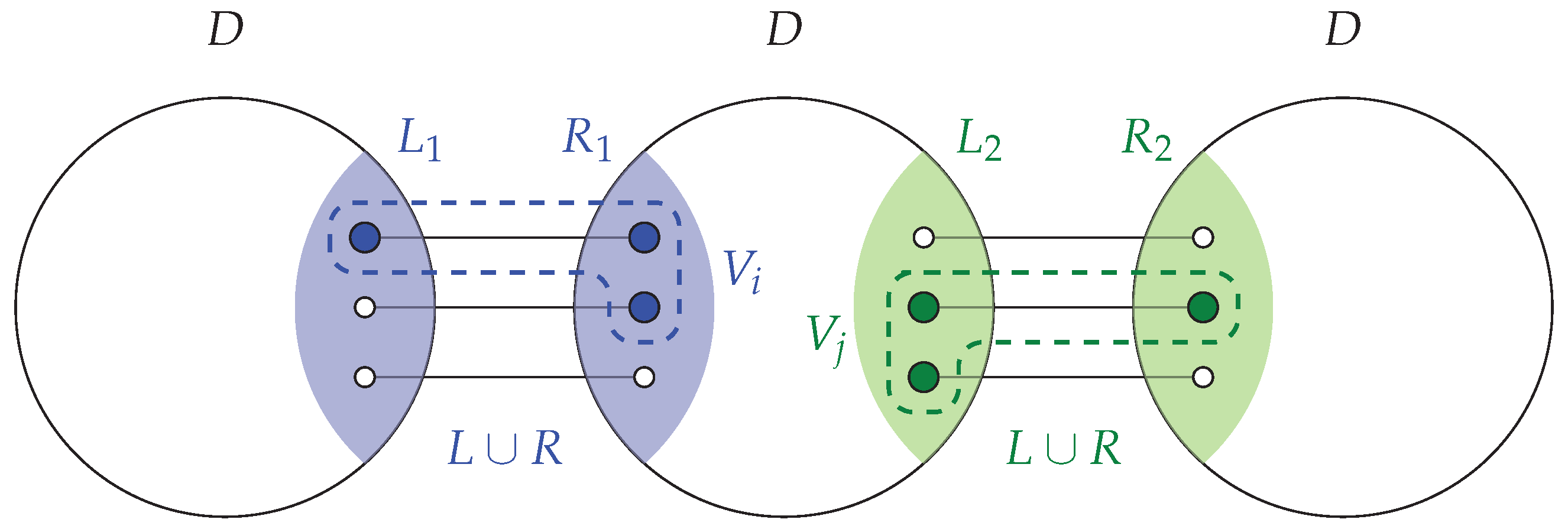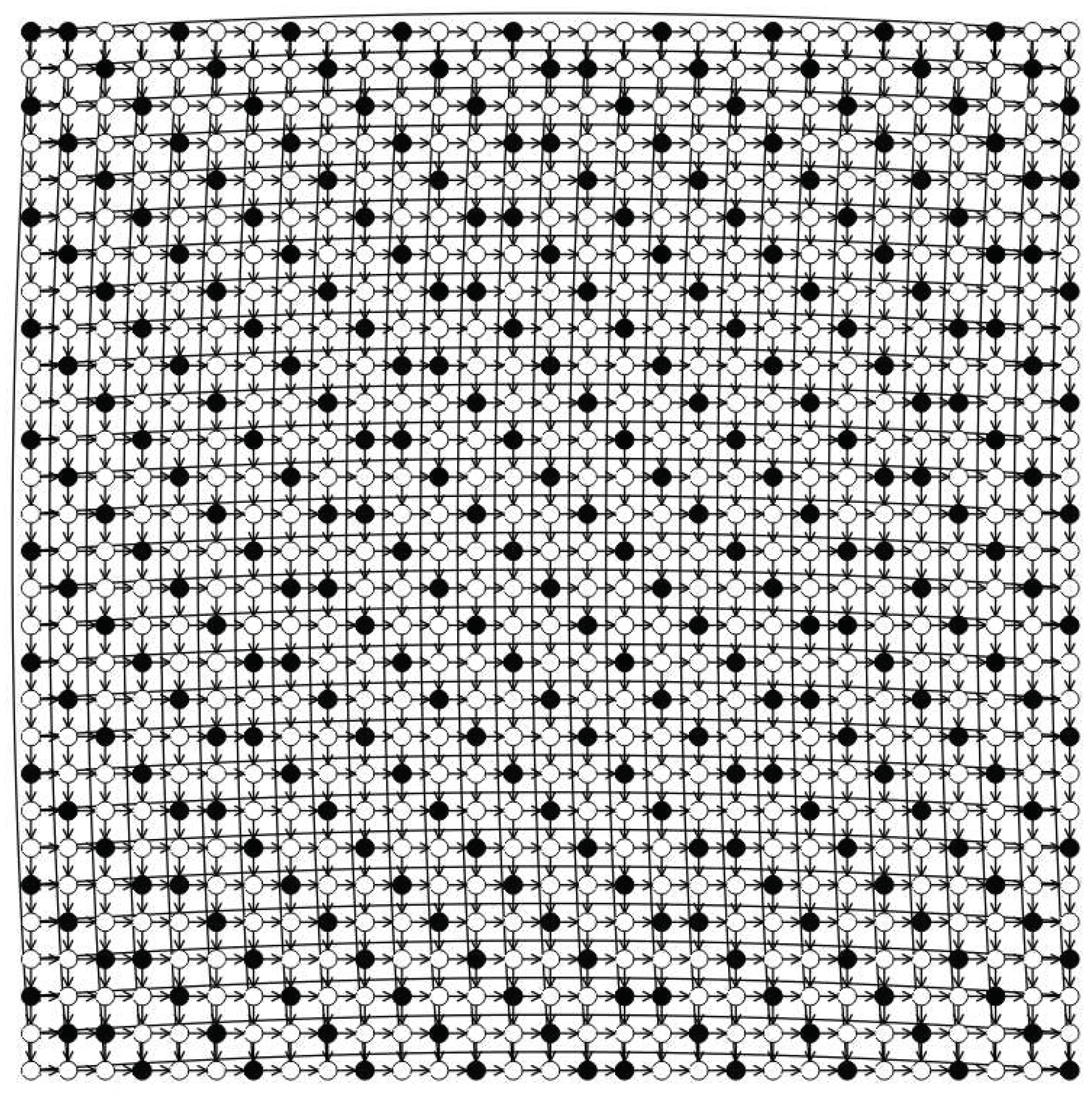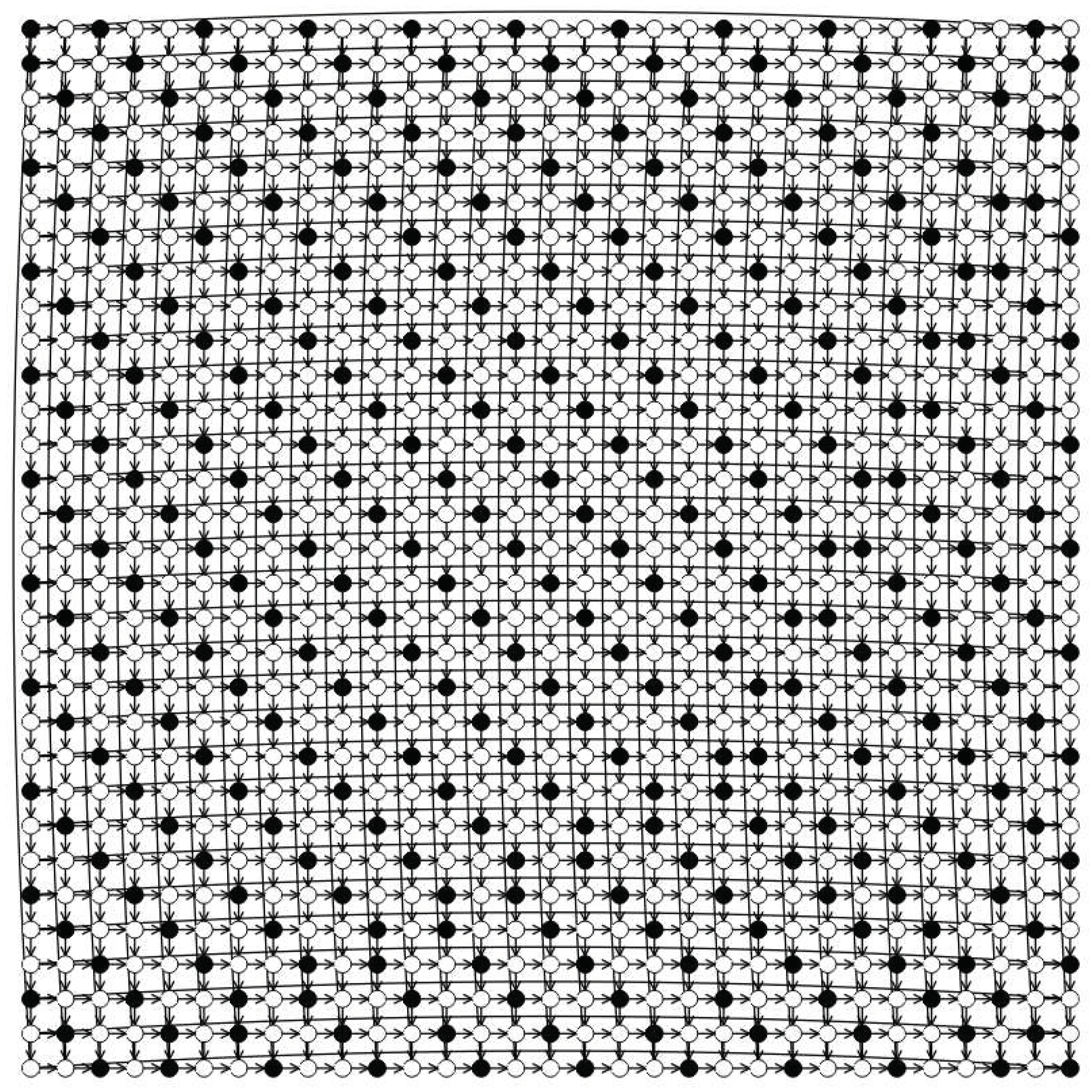1. Introduction
In this paper, we only consider digraphs without multiple edges or loops. For a digraph (or ) with vertex set V, arc set A, and a vertex , and denote the set of out-neighbors and in-neighbors of v, and denote the out-degree and in-degree of v in D, respectively. For two vertices u and v in D, we say u dominates v if or . Let . A vertex v dominates all vertices in . A set is a dominating set of D if S dominates . The domination number of D, denoted by , is the minimum cardinality of a dominating set of D. A dominating set S is called a -set of D if is the minimum cardinality over all dominating sets of D.
The
Cartesian product of graphs
and
is the graph
with the vertex set
, and
if either
and
, or
and
. For more information on the Cartesian product of graphs [
1]. It can be seen that if
and
are directed graphs, then
is also a directed graph. We denote by
and
the directed cycle and directed path with
n vertices, respectively. Then we study the domination number of directed graphs
for
.
Graph domination and associated concepts have been studied for many years and there are more than 200 papers to study on the subject [
2,
3,
4]. Among them, many authors study the domination number of products of graphs [
5,
6], especially for cylinders [
7], torus [
8,
9] and grids [
10]. Liu et al. initiated the study of the domination number of two directed cycles, and they [
11,
12] determined the exact values of
for
m up to 6 and showed that
Theorem 1. if (mod 3) and (mod 3).
Shao et al. [
13] extended the exact values of
for
. Mollard [
14] determined exact values of
for
.
In this paper, we again apply the “
dynamic algorithm”, used in [
15], to extend the exact values of
for
m up to 21. These results go much further from the previous known results. Moreover, the exact values of
with
n up to 31 are determined.
2. The Approach—General Outline
The “
dynamic algorithm” was proposed to compute invariants of fasciagraphs and rotagraphs [
16], and thus it can be used to compute the chromatic number, independence number, domination number etc. of products of graphs. For example, Shao et al. [
13] apply the “
dynamic algorithm” to compute the domination number of Cartesian product of two cycles with one cycle of length 7 or 10 and in [
15] authors derived some formulas for the Roman domination number of products of paths and cycles.
In [
17], the approach was used to derive closed expressions for domination numbers
(for
,
) and domination numbers
and
(for
,
). We recall a brief formal description from [
17].
Let
be arbitrary mutually disjoint (di)graphs, here called
monographs, and
a sequence of sets of arcs. An arc of
joins a vertex of
with a vertex of
(
for
). Furthermore, for convenience we set
. A
polygraph over monographs
is defined in the following way:
For a polygraph
and for
we also define
In general,
does not have to be empty. Special types of polygraphs are rotagraphs and fasciagraphs. If all (di)graphs
are isomorphic to a fixed (di)graph
D and all sets
are equal to a fixed set
X, we call such a graph
rotagraph,
. More precisely, in a rotagraph (1) there are isomorphisms
for
, and
and (2) all sets
are equal to a fixed set
(
for all
i). Losely speaking, a
fasciagraph,
is a rotagraph without edges between the last and the first copy of
D. Formally, in a fasciagraph we have
and
. Note that in a rotagraph, all sets
and
are equal to fixed sets
L and
R (i.e.,
and
). This holds for fasciagraphs with one exception, namely
and
. Clearly, the Cartesian products of paths
are examples of fasciagraphs and Cartesian products of cycles
are examples of rotagraphs. Products of a path and a cycle can be seen either as rotagraphs or as fasciagraphs. In previous work [
15,
17,
18], this fact has been used in studies of undirected graphs to obtain a number of results regarding the products of paths and cycles.
We now recall the definition of a semiring . It is a set P together with two binary operations, ⊕ and ○ such that the following hold:
is a commutative monoid with as a unit;
is a monoid with as a unit;
○ is left– and right–distributive over ⊕;
.
A path algebra is an idempotent semiring. It is well known that a semiring is a path algebra exactly when holds for , the unit of the monoid . Let denote the set of nonnegative integers and the set of positive integers. An example of a path algebra that is important here is .
Let
be a path algebra and let
be the set of all
matrices over
P. Let
and define operations ⊕ and ○ in the usual way:
Note that in the case of the path algebra
, the above definitions can be rewritten as:
equipped with above operations is a path algebra where the units of semiring are the zero matrix and the unit matrix. In our example,
, all elements of the zero matrix are ∞, the unit of the monoid
, and the unit matrix is a diagonal matrix with diagonal elements equal to
and all other elements equal to
.
Let
D be a labeled digraph with a labeling function
ℓ which assigns to every arc of
D an element of a path algebra
P. Let
. The labeling
ℓ of
D can be extended to paths in the following way: For a path
of
D let
Let
be the set of all paths of order
k from
to
in
D and let
be the matrix defined by:
It is well-known [
19] that
Let
be a rotagraph and
a fasciagraph. Set
. Note that in the case of fasciagraphs or rotagraphs, all sets
and
are equal to fixed sets
L and
R, respectively. Therefore we can write
, keeping in mind that this is a disjoint union of sets
L and
R, where
and
. Denote
. The labeled digraph
is defined as follows: (1) elements of vertex set of
are the subsets of
U, denoted
; (2) the label (or, weight) of the arc that joins a subset
with a subset
is the contribution of the monograph
to the solution, assuming the sets
and
are part of the solution. In general however, for example when independent domination is considered, some of the pairs of sets
and
do not allow any feasible solution. In such case either a very large label is given (∞), or the arc
is deleted from
, and consequently
need not be a complete graph.
Consider for a moment
and let
and
(of course
and
(see
Figure 1)). Let
stand for the size of minimum dominating set of
. Then we define a labeling of
,
, in the following way:
We now recall Algorithm 1, first proposed in [
16], that computes the domination number of a fasciagraph or a rotagraph in
time:
| Algorithm 1 The domination number. |
Step 1: Let be a path algebra.
Step 2: Label with the labeling, defined in (1).
Step 3: In calculate .
Step 4: Let and |
This algorithm can be considerably improved because in some cases, computing the powers of
in
time is possible. For example, it is well-known that improvements using special structure of the matrices give rise to constant time algorithm for computation of the domination numbers:
Lemma 1. ([20]) Let and . Then there is an index such that for some index and some constant matrix C. Let . Then for every and every we have Note that this phenomena is not restricted to domination type problems. For example, an analogous lemma for distance based invariants was elaborated already in [
21].
Hence, if we assume that the size of the monograph is a given constant (and n is a variable), the algorithm will run in constant time. But it is important to emphasize that the algorithm is useful for practical purposes only if the number of vertices of the monograph is relatively small. Namely, the matrices are of size , and manipulating such matrices implies that the time complexity is in general exponential in the number of vertices of the monograph. Therefore, a straightforward implementation of the algorithm may have prohibitively long running times.
A method that is particulary useful for fasciagraphs is the following. Observe that one may consider each row of the matrices separately. Thus, instead of using
space, only
is required. Furthermore, depending on the problem, it may not be necessary to compute all the rows of
. Instead of calculating the whole matrices
, the correct answer is obtained if only those rows which are important for the result are calculated and the difference of the new row against the previously stored rows is checked until a constant difference is detected. This idea was used in [
15] on Roman domination problem and in [
22] for pentomino exclusion problem. Formally, it is based on the following lemma
Lemma 2. [15] Assume that the j-th row of and differ by a constant, for all i. Then . The idea may be even easier to explain directly in terms of graphs, avoiding the matrix notation. As we study products of cycles in this paper, we restrict attention to rotagraph type problems. Observe that a dominating set in corresponds to a cycle of length n in the auxiliary graph . This leads to the problem of finding a cycle of length n with minimal weight. Above considerations translate into the ideas that if there is a subset of vertices of that must be in any solution, then we can start the search for cycles on these vertices only.
In this paper we make use of another idea [
13]. Namely, if there are vertices of
that can not be on any minimal cycle, then we can ignore them.
3. The Approach: Details
Below, we define the labelled auxiliary digraph
that can be used to solve our domination problem. Then we provide a procedure for reducing the number of vertices of the auxiliary digraph
, similarly as in [
13]. The dynamic algorithm is then applied on the reduced auxiliary graph.
Before we continue, let us denote
and
a
-layer of
, which corresponds to vertex
Similarly as in [
13], the vertices
v of the auxiliary digraph are represented with a “pattern”, i.e., a dominating set on two consecutive
-layers. A pattern here is a sequence of 0 s and 1 s, where 1 stands for a vertex in a dominating set of
and 0 for a vertex that needs to be dominated from a neighboring vertex. The weight of a vertex
v,
, is defined to be the number of 1 s in a given pattern, i.e.,
, where
S is a dominating set of
. Clearly, for a cycle
C of length
n we have
, since every vertex in
S appears in two consecutive patterns.
The following procedure is used to provide a subset of patterns that will be the vertices of .
ProcedureReduceNumberOfVertices:
- Step 1:
for a fixed m, find an upper bound of in the form of for some ;
- Step 2:
establish a lower bound for the number of vertices in a minimum dominating set of for any
- Step 3:
remove each vertex v in such that .
Remark 1. Procedure ReduceNumberOfVertices can reduce the order of for finding the domination number of .
Let
S be a minimum dominating set of
. Steps 1 and 2 of
Procedure ReduceNumberOfVertices provide
a,
, and
, such that
and
Assume that
S is such a dominating set, that for some
i there is a corresponding vertex
v with
and recall that
.
Let
for each
. It is clear
. Let
Since
for each
j, we have
. Since
, we have
, contradicting Equation (
2) (and the minimality of
S). Therefore, there is no vertex
v of
with
and those vertices can be removed from the auxiliary digraph.
In practice, the procedure ReduceNumberOfVertices reduce the vertices of auxiliary graph dramatically for almost all cases, and we give the following examples:
Example 1. For , let . We label the graph and the constructed auxiliary digraph has 328362 vertices. By removing unnecessary vertices, the auxiliary digraph can be reduced to 16,575 vertices by letting , where are the weight restricted to the first and second column of , respectively.
Example 2. For , let . We label the graph and the constructed auxiliary digraph has 1,169,558 vertices. By removing unnecessary vertices, the auxiliary digraph can be reduced to 2442 vertices by letting , where are the weight restricted to the first and second column of , respectively.
We apply Algorithm 1 with the auxiliary graph reduced by procedure ReduceNumberOfVertices, and it is carried out on a 2.6-GHz Intel(R) Core(TM) i7-5600U CPU with a memory of 20G. As a result we are able to extend the formulae for with m up to 20.










